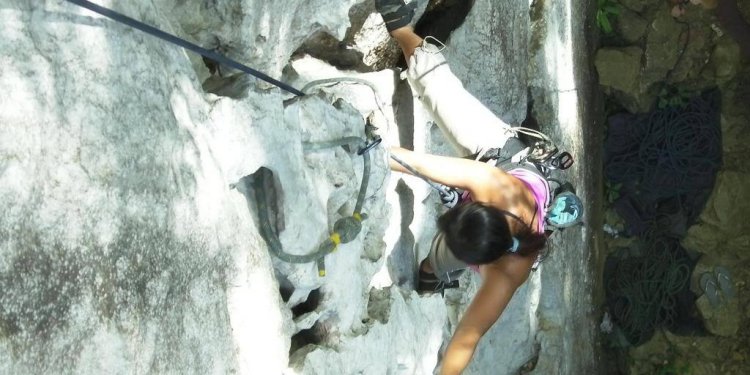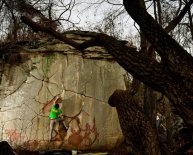
Outdoor Rock climbing gear
Traditional and Crack Climbing Shoes
Shoe for crack climbing will typically have a flatter toe and a symmetrical design. This makes them more comfortable for wedging into cracks and wearing for longer durations. These shoes can also be worn larger for comfort, or to allow room for socks if you're going really high, or climbing with your grandpa. A slight downturn can still be comfortable on the really big days, and will give you an edge in performance when it matters.Shoes for the Gym and Beginners
Depending on how hard you go in the gym, your choice of shoes will vary widely. Again, a flatter toe and larger sizing will prove to be more comfortable (which is highly recommended for those just starting out), but for pushing your limits indoors, a tightly fitted aggressive shoe will go a long way.Lyra on Airy Interlude in the La Sportiva Katana Lace, Needles, CA.
Edging
We tested several shoes reputed to have excellent edging capabilities. Among the models tested, the La Sportiva Genius, Katana Lace, La Sportiva Miura, Miura VS, and TC Pro ranked the highest in this category. Designed to bring the climbers toe into unparalleled contact with the rock, the La Sportiva Genius redefines the standard for performance shoes. Among more traditionally designed shoes the Miura VS ranked very highly.Worthy of the hype, the La Sportiva Genius provides unmatched sensitivity and a tremendous feeling of security even on the most insecure footholds. Though the Genius feels phenomenally precise, it doesn't require perfect placement of your feet to work. The Genius will mold itself onto the thinnest holds, keeping you moving through the most tenuous sections of a climb. This is a tremendous advantage when on-sighting. The shape and sensitivity of the Genius will also allow you to refine the placement of a foothold without transferring your weight. This helps you to minimize movement making you more efficient and provides security by keeping you in contact with the rock.
Let this take nothing away from the Sportiva Miura VS: it is an edging machine. La Sportiva has nailed it with this shoe. It is a fusion of the original Miura, a velcro system, and the pick of an ice climbing tool. The Miura VS stands on anything, and since it has a more traditional design, it will feel familiar, ready to go out of the box. For the Miura VS to really perform for you, you'll have to size it tight. Expect it to be painful, this is a gun-and-done shoe that you take off as soon as you've sent your project. Hold it in reserve for the days when you're really pushing your grade.
For only a marginal sacrifice in edging performance, and a significant increase in comfort and versatility, we recommend the TC Pro, Katana Lace, or Miura, but not necessarily in that order. These three shoes are solid all-arounders that perform well on a variety of terrain. Of the three, the Katana Lace ranks highest in overall versatility, performing well in all our evaluation criteria.
Shoe testing on granite in the Alabama Hills, CA.
Crack Climbing
We tested several shoes generally used for all around climbing, and one specialized trad climbing shoe, the La Sportiva TC Pro. Our favorite crack climbing shoes were the TC Pro and Katana lace, both from La Sportiva. They are both comfortable out of the box and keep your foot in a relatively flat position, ideal for crack climbing. They have their individual strengths, and excel at different styles of crack climbing. The TC Pro does well in all but the thinnest cracks. It feels precise, and the padding above the toe makes a noticeable difference when jamming. The TC Pro really thrives on the wide stuff, where the thin padding above the ankle offers excellent protection. The Katana Lace's tech fit and medium asymmetry give it an advantage when cracks get thin and technical. In anything thinner than the ankle-chewing wide cracks, where the TC Pro thrives, the shoes ranked very similarly. Other shoes that ranked well in testing were the La Sportiva Miura and the Anasazi VCS great alternatives if the Katana Lace or TC pro isn't the right fit for your foot. If you plan to climb sandstone splitters at Indian Creek for a month every spring and fall, you can't do any better than the classic and comfy Five Ten Moccasym.The down turned toe of the Katana lace gives it an advantage over the TC Pro in thinner cracks. Overall these shoes perform very similarly.
Pockets
The La Sportiva Miura VS and Genius go head-to-head again for the title of best shoe in pockets. These shoes ranked very similarly, both performing exceptionally, and getting it done in spectacularly different style. Both shoes feature aggressively down turned toes, and a P3 ("Power, Performance, Platform") midsole that helps them hold their shape. The Miura VS relies on pinpoint precision to really perform contrasted with the Genius the Miura VS felt blind on the rock. The Genius allowed us to climb more naturally, particularly on unfamiliar terrain. The other significant difference in the performance of these two shoes is their comfort. We were able to keep the Genius on between attempts at bouldering problems, and they let us hang out on sport climbing projects in comfort. While the Miura VS did provide incentive (in the form of pain) to get through a climb, we'd opt for the comfort of the Genius any day. That being said, neither of these shoes are wear-all-day comfortable. For a shoe that you can wear on both long sport and traditionally protected routes, but that will still get it done on steep pocketed terrain, check out the La Sportiva Katana Lace. The Katana lace has a tech fit, meaning that it has a slightly down turned toe, but your foot remains fairly flat with a medium asymmetry. This compromise between a neutrally shaped climbing shoe and one with a much more aggressive shape creates a remarkably balanced shoe.Lyra and Lindsay testing rubber in Index, WA.
Sensitivity
The Genius is only rivaled only by the La Sportiva Futura as the most sensitive shoe we've ever tested. The most immediately recognizable benefit of the No Edge concept is how well you can feel the rock in the Genus or Futura. This shoe pastes itself onto blank faces better than many of the best edging shoes stuck to their edges. Sensitivity plays an enormous role in smearing. Both No-Edge concept shoes were able to move through low angle terrain as easily as the steep stuff. As a down turned shoe, this is a testament to the function of having a more sensitive shoe. An honorable mention goes to the Five Ten Team. While it didn't rank very highly overall, it is impressively sensitive and sticky.Lyra testing of the Katana Lace on the Mammoth Boulders, California
Comfort
The comfort of your climbing shoe typically depends on a few things: how you size the shoe, your foot position, and the shoe's upper material. Generally speaking, the tighter your shoe, the better it will perform. The contrary is also true: the looser the shoe the worse it performs. Typically, tight equals painful and loose equals comfortable. However, if your shoes are so tight you can't put pressure on your toes, you may have reached the point of down-sizing where it is counterproductive.The La Sportiva Tarantula is a decent compromise between performance and comfort. This is a shoe designed with comfort in mind. Though not suitable for high-end climbing, the rounded shape, flat foot position, and higher volume fit of the shoe allows you to size the Tarantula tightly for performance without sacrificing comfort. The TC Pro and the Mad Rock Flash are flat shoes that have a much higher level of performance, but are still quite comfortable.
The TC Pro is an excellent choice for an all day shoe, particularly for long routes. The Mad Rock Flash is not the best performing shoe, but ranks higher than the La Sportiva Tarantula, and is very comfortable.
A down-turned toe and asymmetrical shape typically mean a shoe is less comfortable, but a more aggressive shape also enhances performance in many aspects of climbing. With modern technology and design, climbing performance and comfort are no longer mutually exclusive concepts. The Katana Lace and Futura both offer comfort and performance at a very high level: The Katana is a very solid all-around performer, and the Futura is a high-end sport shoe.
Accessories
Having a durable and versatile climbing rope is important to the safety of all climbers. Two of our favorites are the Mammut Infinity and the Sterling Evolution Velocity. Check out The Best Rock Climbing Rope Review for a more in-depth look at all the ropes we reviewed.The Bottom Line
The announcement of our award winners should be proceeded by a disclaimer: reviews are inherently subjective (for example, some people think Vertical Limit is a good movie), and rock shoe reviews seem particularly so. Our individual assessment of a particular shoe is largely contingent on the shape of our testers' feet, what type of rock we climbed, and how tight we sized them. However, we have meticulously researched these shoes (primarily by climbing in them a lot), and talked to a lot of industry professionals that use and sell these shoes routinely. There are a bunch of great shoes out there, and in an expanding market, there are more all the time. Please let us know what you'd like to see reviewed. Thanks!History
Today, it's hard to imagine rock climbing without cranking down a tight pair of high performance sticky rubber-soled climbing shoes. Rarely do we think of the incredible technological improvements that have gone into climbing footwear over the last one hundred years. The different shapes, the different fits, and most of all, the different rubbers all have long histories in and of themselves. Lets take a look back at the first iterations of the climbing shoe in Europe.In the late 19th century, rock climbing began to develop as a form of practice for the climbing required to arrive on the summits of mountains. The terrain being tackled in these early years was relatively easy by today's standards. However, to fully understand the difficulty we must examine the context in which these climbs were being done and it is most important to look to the footwear and gear being used by these early climbers. As these men (and a few women) became more serious in their pursuit to summit great mountains, they took to their local boulders and cliffs to practice their skills. These early climbers began scrambling on the local cliffs in the same footwear they would use in the mountains. Often this was a form of hob-nailed boot, a leather-soled, ankle high boot with metal studs pounded through the soles.
Well into the early 20th century, these hob-nail boots were the standard for many European climbers. In some regions, climbers began to explore a softer soled canvas shoe for climbing, but the major improvements came out of Europe in the 1930s. During the 20s and 30s, the French mountaineering club were meeting to 'practice climb' on the boulders outside of Paris in order to prepare for their trips to the mountains. By 1935 one particular Frenchman, Pierre Allain, was becoming more and more interested in not just climbing on these boulders as practice, but to climb for the pure challenge of it.
Allain was at the forefront of the early climbing development taking place in the famous Fontainebleau forest near Paris. Allain recognized that a new style of shoe was needed to improve ones footwork while on the rock, so he began developing a smooth-rubber soled shoe intended specifically for climbing on rocks. This was perhaps the first climbing specific piece of footwear created. The shoe looks very similar to a modern climbing shoe but lacks the 'sticky rubber' and instead has a traditional hard rubber sole that simply lacks any lug pattern.
In 1935 another mountaineer and climber, the Italian Vitale Bramani, found a need for better mountain footwear after six of his friends lost their lives in the Italian Alps. Bramani teamed with Leopoldo Pirelli of Pirelli Tires to create Vibram soles, the first rubber lug soled boots commercially available. These were game changing. Vibram soled boots became the standard for climbing and mountain endeavors for the next 25 years or more and carried climbers for the first time to the summits of many impressive high altitude peaks, including K2.
As climbers continued to push the limits in the mountains and at their local climbing areas, many people experimented with different shoe styles. In the 1940's, Joe Brown, an Englishman, began to experiment with climbing in plimsolls, a canvas topped, rubber soled shoe, similar to todays Keds. In these shoes he established many famous routes across the Peak district of England.
By 1948, Pierre Allain had improved his original smooth-rubber soled shoe design and in 1950 he marketed them commercially as PA's. These shoes were the first climbing specific shoes on the market, a shoe specifically for rock climbing and not intended as a mountaineering boot that would climb well. These shoes were used on many legendary climbs in the Alps, including the first ascent of the north face of the Dru. Still in his quest to push the limits of difficulty, Allain was limited by his footwear until he met Eduard Bourdenneau.
Eduard Bourdenneau was an expert shoe maker who teamed with Pierre Allain in 1950 to create the iconic climbing shoe, The EB. EB's utilized a softer rubber than it's predecessor, the PA. By the late 60s, the flagship shoe, The Super Gratton, was the climbing shoe of choice around the world. It was in this climbing shoe that free climbing began to press into substantially more difficult terrain; 5.11, 5.12 and even 5.13 grades were established across the globe as a direct result of this legendary shoe.

















